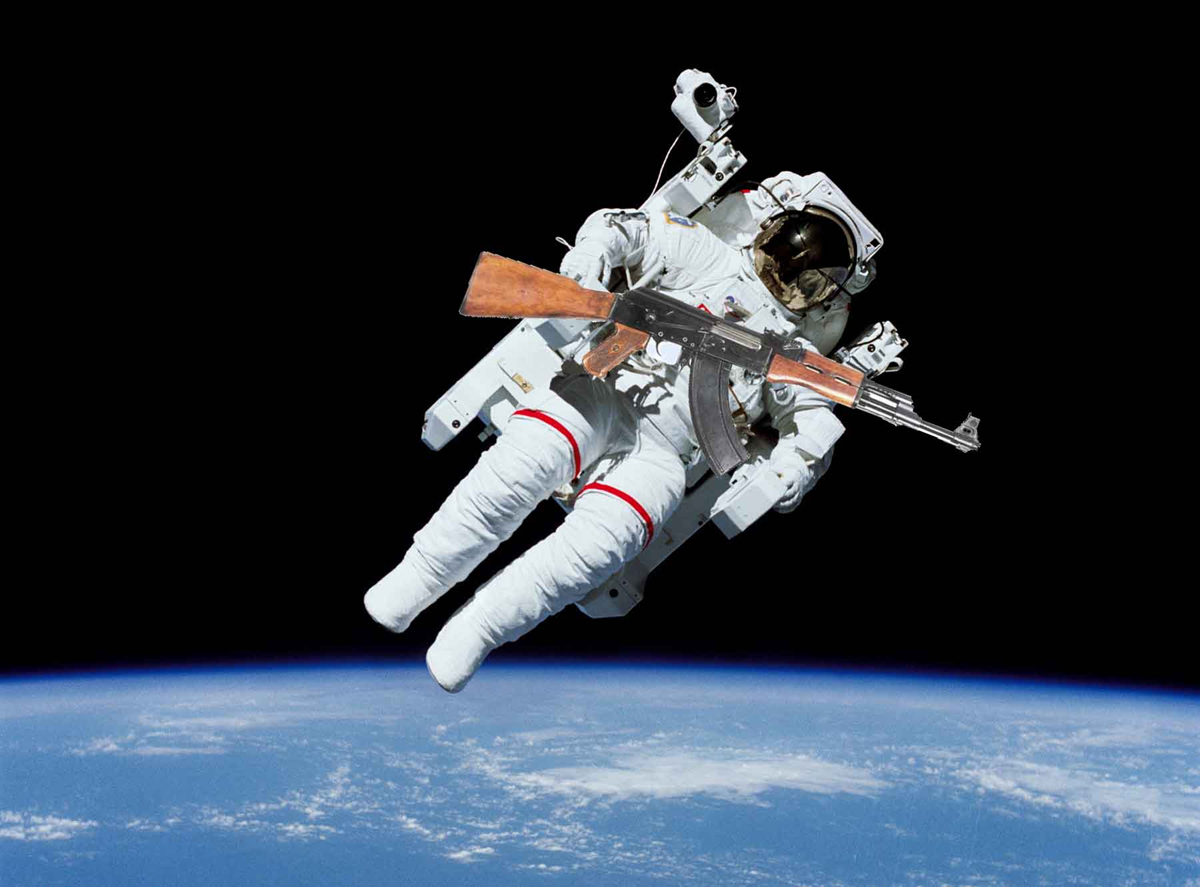What Would Happen If You Shot a Gun in Space?

Fires can't burn in the oxygen-free vacuum of space, but guns can shoot. Modern ammunition contains its own oxidizer, a chemical that will trigger the explosion of gunpowder, and thus the firing of a bullet, wherever you are in the universe. No atmospheric oxygen required.
The only difference between pulling the trigger on Earth and in space is the shape of the resulting smoke trail. In space, "it would be an expanding sphere of smoke from the tip of the barrel," said Peter Schultz an astronomer at Brown University who researches impact craters.
The possibility of gunfire in space allows for all kinds of absurd scenarios.
Imagine you're floating freely in the vacuum between galaxies — just you, your gun and a single bullet. You have two options. You either can spend all of eternity trying to figure out how you got there, or you can shoot the damn cosmos.
If you do the latter, Newton's third law dictates that the force exerted on the bullet will impart an equal and opposite force on the gun, and, because you're holding the gun, you. With very few intergalactic atoms against which to brace yourself, you'll start moving backward (not that you’d have any way of knowing). If the bullet leaves the gun barrel at 1,000 meters per second, you — because you're much more massive than it is — will head the other way at only a few centimeters per second.
Once shot, the bullet will keep going, quite literally, forever. "The bullet will never stop, because the universe is expanding faster than the bullet can catch up with any serious amount of mass" to slow it down, said Matija Cuk, an astronomer with joint appointments at Harvard University and the SETI Institute. (If the universe weren't expanding, then the one or two atoms per cubic centimeter encountered by the bullet in the near-vacuum of space would bring it to a standstill after 10 million light-years.)
Getting down to details, the universe expands at a rate of 73 kilometers per second per megaparsec (about 3 million light-years, or the average distance between galaxies). By Cuk's calculations, this means matter that is 40,000 to 50,000 light-years away from the bullet would move away from it at about the same speed at which it is travelling, and would thus be forever out of reach. In the entire future of the universe, the bullet will catch up only to atoms that are less than 40,000 or so light-years from the chamber of your gun.
Get the Space.com Newsletter
Breaking space news, the latest updates on rocket launches, skywatching events and more!
Speaking of you, you'll be bobbing through space forever, too. [Album: Visualizations of Infinity]
Shooting giants from the hip
Guns do actually get carried to space, though not quite to the void between galaxies. For decades, the standard survival pack for Russian cosmonauts has included a gun. Until recently, it wasn't just any gun, but "a deluxe all-in-one weapon with three barrels and a folding stock that doubles as a shovel and contains a swing-out machete," according to space historian James Oberg. The space guns are issued in case the cosmonauts need one back on Earth, so that they can protect themselves if emergency landing of their Soyuz spacecraft has left them deserted in a treacherous region. But still, cosmonauts in theory could shoot their guns before they landed.
So what if, during a spacewalk, a cosmonaut opened fire on Jupiter?
He or she should feel free to shoot from the hip. According to Robert Flack, a physicist at University College London, the enormous gravitational field of Jupiter is likely to suck in a bullet even if it is badly aimed. "Jupiter is so huge, it will capture the bullet and then it will follow a curved path down into the planet," Flack said.
And as it does, it will pick up some serious steam. According to Schultz, if the bullet is shot straight toward Jupiter, the planet's gravity will accelerate the ammo to the eye-popping speed of almost 60 kilometers per second by the time it crosses the gas giant's threshold.
Watch your back
Shooting someone in the back is a cowardly act. In space, "theoretically you could shoot yourself in the back," Schultz said.
You could do it, for example, while in orbit around a planet. Because objects orbiting planets are actually in a constant state of free fall, you have to get the setup just right. You'd have to shoot horizontally at just the right altitude for the bullet to circle the planet and fall back to where it started (you). And you'd also have to consider how much you'll get kicked backwards (and consequently, how much your altitude will change) when you fire.
"The aim has to be perfect," Schultz said.
Such a scenario isn't as absurd as it sounds. In fact, Schultz said scientists at one point were considering setting up such a self-hit in space in order to investigate the effects of high-speed impacts.
However, considering all the math involved, Cuk suggests it might be easier to commit space suicide by standing on a mountain on the moon. "'Shooting yourself in the back' works in principle if you shoot a bullet at horizon from the top of a lunar mountain, at 1600 meters per second or so," he said. He thinks it just might work as long as you adjust your aim to account for lumps and irregularities in the shape of the moon, which would affect the altitude of the bullet as it travels.
With so many possible movie plotlines to consider, one question remains: Why are there so few space shoot 'em ups?
Follow Natalie Wolchover on Twitter @nattyover. Follow Life's Little Mysteries on Twitter @llmysteries, then join us on Facebook.
Join our Space Forums to keep talking space on the latest missions, night sky and more! And if you have a news tip, correction or comment, let us know at: community@space.com.

Natalie Wolchover was a staff writer for Live Science and a contributor to Space.com from 2010 to 2012. She is now a senior writer and editor at Quanta Magazine, where she specializes in the physical sciences. Her writing has appeared in publications including Popular Science and Nature and has been included in The Best American Science and Nature Writing. She holds a bachelor's degree in physics from Tufts University and has studied physics at the University of California, Berkeley.










